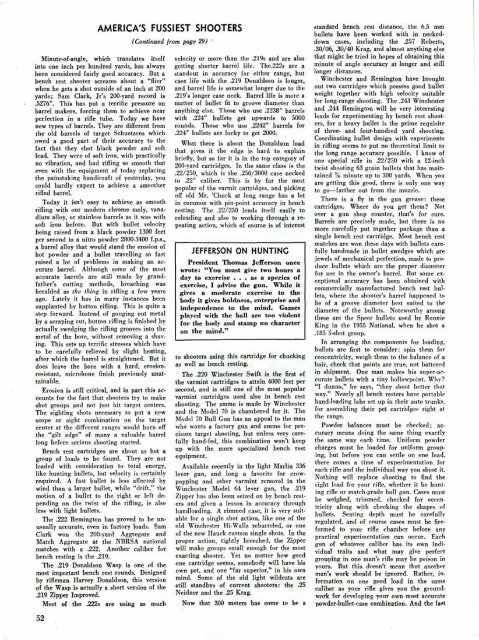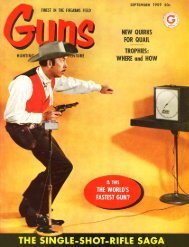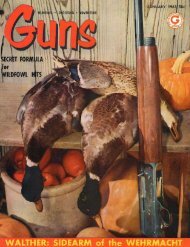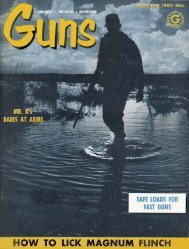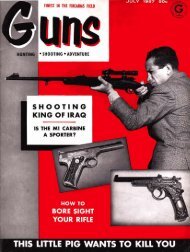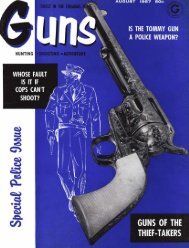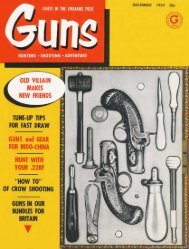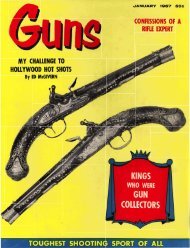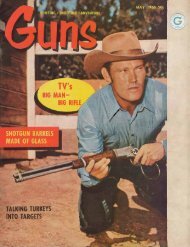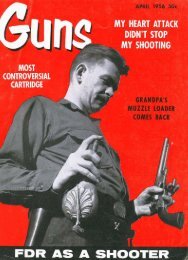You also want an ePaper? Increase the reach of your titles
YUMPU automatically turns print PDFs into web optimized ePapers that Google loves.
Minute-of-angle, which translates itself<br />
into one inch per hundred yards, has always<br />
been considered fairly good accuracy. But a<br />
bench rest shooter screams about a "flier"<br />
when he gets a shot outside of an inch at 200<br />
yards; Sam Clark, Jr's 200-yard record is<br />
- .5276". This has put a terrific pressure on<br />
barrel makers, forcing them to achieve near<br />
perfection in a rifle tube. Today we' have<br />
new types of barrels. They are different from<br />
the old barrels of target Schuetzens which<br />
owed a good part of their accuracy to the<br />
fact that they shot black powder and soft<br />
lead. They were of soft iron, with practically<br />
no vibration, and had rifling so smooth that<br />
even with the equipment of today replacing<br />
the painstaking handicraft of yesterday, you<br />
could hardly expect to achieve a smoother<br />
rifled barrel.<br />
Today it isn't easy to achieve as smooth<br />
rifling with our modem chrome moly, vana-<br />
dium alloy, or stainless barrels as it was with<br />
soft iron before. But with bullet velocity<br />
being raised from a black powder 1300 feet<br />
per second to a nitro powder 2800-3400 f.p.s.,<br />
a barrel alloy that would stand the erosion of<br />
hot powder and a bullet travelling so fast<br />
raised a lot of problems in making an ac-<br />
curate barrel. Although some of the most<br />
accurate barrels are still made by grand-<br />
father's cutting methods, broaching was<br />
heralded as the thing in rifling a few years<br />
ago. Lately it has in many instances been<br />
supplanted by button rifling. This is quite a<br />
step forward. Instead of gouging out metal<br />
by a scraping cut, button rifling is finished by<br />
actually swedging the rifling grooves into the<br />
metal of the bore, without removing a shav-<br />
ing. This sets up terrific stresses which have<br />
to be carefully relieved by slight heating,<br />
after which the barrel is straightened. But it<br />
does leave the bore with a hard, erosion-<br />
resistant, microhone finish previously unat-<br />
tainable.<br />
Erosion is still critical, and in part this ac-<br />
counts for the fact that shooters try to make<br />
shot groups and not just hit target centers.<br />
The sighting shots necessary to put a new<br />
scope or sight combination on the target<br />
center at the different ranges would burn off<br />
the "gilt edge'' of many a valuable barrel<br />
long before serious shooting started.<br />
Bench rest cartridges are about as hot a<br />
group of loads to be found. They are not<br />
loaded with consideration to total energy,<br />
like hunting bullets, but velocity is certainly<br />
required. A fast bullet is less affected by<br />
wind than a larger bullet, while "drift," the<br />
motion of a bullet to the right or left de-<br />
pending on the twist of the rifling, is also<br />
less with light bullets.<br />
The .222 Remington has proved to be un-<br />
usually accurate, even in factory loads. Sam<br />
Clark won the 200-yard Aggregate and<br />
Match Aggregate at the NBRSA national<br />
matches with a .222. Another caliber for<br />
bench resting is the .219.<br />
The .219 Donaldson Wasp is one of the<br />
most important bench rest rounds. Designed<br />
by rifleman Harvey Donaldson, this version<br />
of the Wasp is actually a short version of the<br />
2V) Zipper Improved.<br />
Most of the 222s are using as much<br />
AMERICA'S FUSSIEST SHOOTERS<br />
(Continued from page 29) '<br />
velocity or more than the 219s and are also<br />
getting shorter barrel life. The.222~ are a<br />
standout in accuracy for either range, but<br />
case life with the .219 Donaldson is longer,<br />
and barrel life is somewhat longer due to the<br />
.219's longer case neck. Barrel life is more a<br />
matter of bullet fit to groove diameter than<br />
anything else. Those who use .2238" barrels<br />
with 224'" bullets get upwards to 5000<br />
rounds. Those who use .2242" barrels for<br />
224" bullets are lucky to get 2000.<br />
What there is about the Donaldson load<br />
that gives it the edge is hard to explain<br />
briefly, but so far it is in the top category of<br />
200-yard cartridges. In the same class is the<br />
.22/250, which is the .250/3000 case necked<br />
to .22" caliber. This is by far the most<br />
popular of the varmit cartridges, and picking<br />
off old Mr. 'Chuck at long range has a lot<br />
in common with pin-point accuracy in bench<br />
resting. The .22/250 lends itself easily to<br />
reloading and also to working through a repeating<br />
action, which of course is of interest<br />
JEFFERSON ON HUNTING<br />
President Thomas Jefferson once<br />
wrote: "You must give two hours a<br />
day to exercise . . . as a species of<br />
exercise, I advise the gun. While it<br />
gives a moderate exercise to the<br />
body it gives boldness, enterprise and<br />
independence to the mind. Games<br />
~layed with the ball are too violent<br />
for the body and stamp no character<br />
on the mind."<br />
to shooters using this cartridge for chucking<br />
as well as bench resting.<br />
The .220 Winchester Swift is the first of<br />
the varmint cartridges to attain 4000 feet per<br />
second, and is still one of the most ~opular<br />
varmint cartridges used also in bench rest<br />
shooting. The ammo is made by Winchester<br />
and the Model 70 is chambered for it. The<br />
Model 70 Bull Gun has an appeal to the man<br />
who wants a factory gun and ammo for pre-<br />
cision target shooting, but unless very care-<br />
fully hand-fed, this combination won't keep<br />
up with the more specialized bench rest<br />
equipment.<br />
Available recently in the light Marlin 336<br />
lever gun, and long a favorite for crowpopping<br />
and other varmint removal in the<br />
Winchester Model 64 lever gun, the .219<br />
Zipper has also been seized on by bench resters<br />
and given a lesson in accuracy through<br />
handloading. A rimmed case, it is very suitable<br />
for a single shot action, like one of the<br />
old Winchester Hi-Walls rebarreled, or one<br />
of the new Hauck custom single shots. In the<br />
proper action, tightly breeched, the Zipper<br />
will make groups small enough for the most<br />
exacting shooter. Yet no matter how good<br />
one cartridge seeins, somebody will have his<br />
own pet, and one "fai superior," in his own<br />
mind. Some of the old light wildcats are<br />
still standbys of current shooters: the .25<br />
Neidner and the 25 Krag.<br />
Now that 300 meters has come to be a<br />
standard bench rest distance, the 6.5 mm<br />
bullets have been worked with in necked-<br />
down cases, including the 257 Roberts,<br />
.30/06, .30/40 Krag, and almost anything else<br />
that might be tried in hopes of obtaining this<br />
minute of angle accuracy at longer and still<br />
longer distances.<br />
Winchester and Remington have brought<br />
out two cartridges which possess good bullet<br />
weight together with high velocity suitable<br />
for long-range shooting. The .243 Winchester<br />
and .244 Remington will be very interesting<br />
loads for experimenting by bench rest shoot-<br />
ers, for a heavy bullet is the prime requisite<br />
of three and four-hundred yard shooting.<br />
Coordinating bullet design with experiments<br />
in rifling seems to put no theoretical limit to<br />
the long range accuracy possible. I know of<br />
one special rifle in .22/250 with a 12-inch<br />
twist shooting 63 grain bullets that has main-<br />
tained % minute up to 300 yards. When you<br />
are getting this good, there is only one way<br />
to go-farther out from the muzzle.<br />
There is a fly in the gun grease: these<br />
cartridges. Where do you get them? Not<br />
over a gun shop counter, that's for sure.<br />
Barrels are precisely made, but there is no<br />
more carefully put together package than a<br />
single bench rest cartridge. Most bench rest<br />
matches are won these days with bullets care-<br />
fully handmad,e in bullet swedges which are<br />
jewels of mechanical perfection, made to pro-<br />
duce bullets which are the proper diameter<br />
for use in the owner's barrel. But some ex-<br />
ceptional accuracy has been obtained with<br />
commercially manufactured bench rest bul-<br />
lets, where the shooter's barrel happened to<br />
be of a groove diameter best suited to the<br />
diameter of the bullets. Noteworthy among<br />
these are the Speer bullets used by Ronnie<br />
King in the 1955 National, when he shot a<br />
.I85 5-shot group.<br />
In arranging the components for loading.<br />
bullets are first to consider: spin them for<br />
concentricity, weigh them to the balance of a<br />
hair, check that points are true, not battered<br />
in shipment. One man makes his super-ac-<br />
curate bullets with a tiny hollowpoint. Why?<br />
"I dunno," he says, "they shoot better that<br />
way." Nearly all bench resters have portable<br />
hand-loading labs set up in their auto trunks.<br />
for assembling their pet cartridges right at<br />
the range.<br />
Powder balances must be checked; ac-<br />
curacy means doing the same thing exactly<br />
the same way each time. Uniform powder<br />
charges must be loaded for uniform group-<br />
ing, but before you can settle on one load.<br />
there comes a time of experimentation for<br />
each rifle and the individual way you shoot it.<br />
Nothing will replace shooting to find the<br />
right load for your rifle, whether it be hunt-<br />
ing rifle or match-grade bull gun. Cases must<br />
be weighed, trimmed, checked for eccen-<br />
tricity along with checking the shapes of<br />
bullets. Seating depth must be carefully<br />
regulated, and of course cases must be fire-<br />
formed to your rifle chamber before any<br />
practical experimentation can occur. Each<br />
gun of whatever caliber has its own indi-<br />
vidual traits and what may give perfect<br />
grouping in one man's rifle may he poison in<br />
yours. But this doesn't mean that another<br />
man's work should be ignored. Rather, in-<br />
formation on one good load in the same<br />
caliber as your rifle gives you the ground-<br />
work for developing your own most accurate<br />
powder-bullet-case combination. And the last


